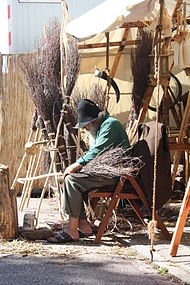Broom binders
Besenbinder describes the traditional trade or the craft of tying brooms . Suitable parts of plants are collected or grown around the world, especially in Asia some village communities specialize in the production of brooms of all kinds, some of which are handcrafted. In the industrialized countries , this manual activity has largely disappeared, replaced by the serial production of plastic brooms. The manufacture of brooms developed from a seasonal activity in everyday farming to a domestic and widespread travel trade . Also Bürstenbinder ask some brush types ago. In Germany, only a few people are familiar with tying brooms with natural materials; in the past, birch brushwood was used here ( birch twigs , compare birch rod ), and gorse also made slender and flexible twigs for it. Common heather (heather) is still used in Great Britain today . The brooms have always been used primarily as stable and street brooms. Broom binding is now practiced by some people as a hobby , also for the purpose of cultural maintenance and remembrance culture .
In the north-east of India, the settlements of the indigenous people of the Khasi are considered to be “the cleanest villages in all of Asia”. The residents keep them well-kept and during the short dry season (December – February) they sweep them daily. Entire villages here do the artful broom-making because the forest and jungle surroundings offer suitable plants for it, some of which are specifically cultivated.
history


The job of the broom-maker is particularly valued in Grimm's fairy tale Die Schöne Katrinelje and Pif Paf Poltrie . The life of a broom- maker (Besenmannli) tells Jeremias Gotthelf in 1851 in Der Besenbinder von Rychiswyl .
The traditional Röttenbach song proudly reports from Franconia:
“Where the gorse blooms so yellow on the edge of the forest.
Our ancestors struggled with it.
Your brooms made Röttenbach known.
We are called broom binders in town and country ... "
Fire prevention
After entire rows of houses burned down in many villages in southern Germany when a fire broke out, strict regulations were issued in the 18th century under Count Palatine Karl IV. To prevent fires; these regulated and the nightly removal of wood chips in the workshops of broom, brush and Cooper ( Cooper ).
Web links
Individual evidence
- ^ Helmut Seebach : Old crafts and trades in the Palatinate - Palatinate Forest . Annweiler-Queichhambach, 1994, p. 88 ff.
- ^ Rainer Beichler: Dying professions: The broom-maker . In: eisenachonline.de . July 19, 2005, accessed on October 10, 2018. Quote: "This rare profession has almost died out and yet many stable owners long for these hand-made brooms made of birch twigs [...]."
- ↑ Article: The broom-maker Klaus Hoffmann from Udersleben tells . In: Thuringian General . April 16, 2011, accessed on October 10, 2018. Quote: “Udersleben in the Kyffhäuserkreis. The 54-year-old has an almost forgotten craft: he ties brooms. "
- ↑ Global 3000: What is life like in matriarchy? W. Feuersenger, S. Barbaruah for Deutsche Welle , August 28, 2017 (5 minutes; video time (from 0:04:42) on YouTube).
- ^ Franz-Josef Sehr : The fire extinguishing system in Obertiefenbach from earlier times . In: Yearbook for the Limburg-Weilburg district 1994 . District Committee of the District of Limburg-Weilburg, Limburg-Weilburg 1993, p. 151-153 .
